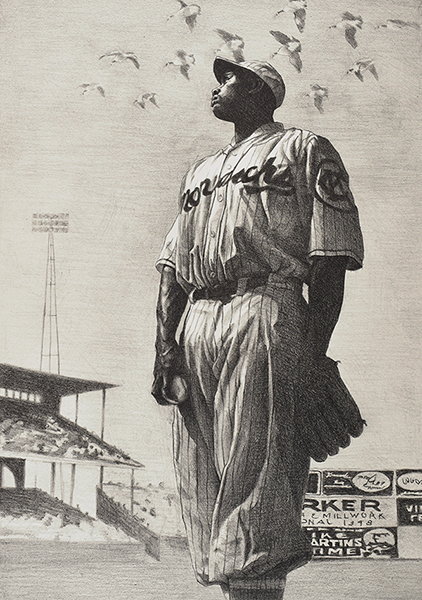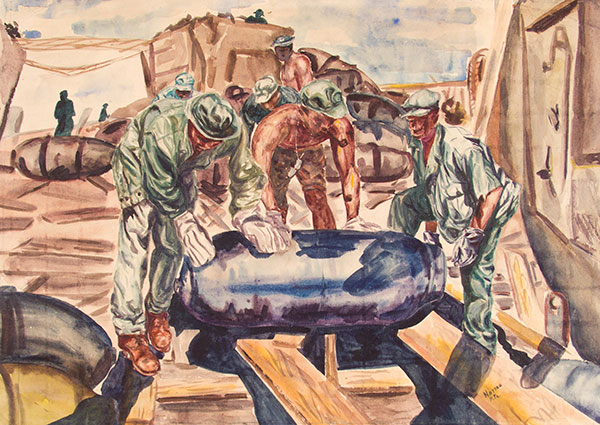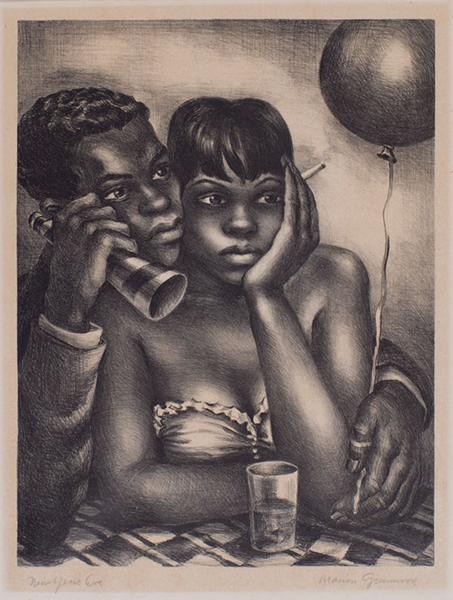THE STRUGGLE FOR CONTROL – Some Control
What impact do we feel when both artist and subject have some control over the image?

Leroy Allen, Winds of Change, 2003, Lithograph; Purchased by 2022 Collectors Circle.
The Negro baseball leagues were the answer to the whites-only professional baseball teams that traveled nationally. But the names of many of the greatest players of the time, 1920 to 1948, may well be lost to history, because of the separate and unequal practices of the time. Satchel Paige, believed to be depicted here, along with Jackie Robinson and a few others, integrated the big leagues -- enduring abuses by resistant sports fans, and sometimes teammates and League officials. Paige was among the most visible firsts in American society as segregation neared its end in the late 1940's. There could never have been a question of his “losing it” or fighting back with anything other than the best professional performance he could proffer. Much like the activists of the Civil Rights Movement, Paige would have been advised of proper comportment as a public figure challenging the status quo. We must imagine that, for a young Black child of the time, images like this would have garnered no less admiration than would have been bestowed on a Black superhero in a cape. Here artist and subject are aligned, though they did not collaborate, both seem to have been intent on controlling the image of a Black man, to produce a message of pride and respect.

Maurice Lindsey, Untitled, c. 1943, Watercolor; Gift of Gene Wagner, 1985.
This untitled piece may very well be a watercolor rendering of a photograph from a current events magazine. The muted colors throughout contrast with the heavy lifting by the three men in the foreground. The uniforms and dog tags indicate these are Black soldiers loading equipment in a war effort. Though Black men, and later women, have served the US military in every conflict since the Revolutionary War, that service was most often segregated; and Black soldiers typically were relegated to manual labor. Despite such treatment, Black soldiers worked in their mandatory support roles honorably and, when the opportunity presented itself, fought and sacrificed in battle with the same pride and determination as their white comrades. No doubt, some of the pressure to perform was rooted in stereotype threat; soldiers made an intentional effort to contradict negative beliefs about Black men and people of color in general. Among the greatest disappointments the soldiers experienced was the return to civilian life and the humiliations of segregation back home. Many Black veterans and observers credited military service as a training ground for leadership and self-determination. And in fact, the gains of the Civil Rights Movement may have been stirred on by the rightful expectation of fair treatment for returning soldiers after World War II.

Marion Greenwood, New Year's Eve, 1942, Lithograph; Gift of Pat Jones, 2006.
Though Greenwood, the artist, is white, the image of this couple on what should be a celebratory evening is curiously complicated. The textures are nuanced, and the people are illustrated with care and respect. In 1942, only urban communities, largely in the Northeast and Midwest of the country would have opportunities for a secular celebration on December 31. Southern Blacks were still mostly congregating at church, observing the Watch Night tradition that began in 1862. Former slaves had been afraid of the potential backlash from whites when the Emancipation Proclamation was to be issued on 1 January 1863. Whether the couple here are celebrating at a house party or night club is not evident in the image. However, despite balloons, noisemakers and drinks, they are not ringing in the new year with much joy. Are they uncertain of what lies ahead? Or, perhaps certain their circumstances will not change much in the era of segregation and limited opportunity? Whatever the trouble, they clearly plan to face it together.
-
Tuesday - Friday
10:00AM - 5:00PMSaturday
1:00PM - 5:00PM